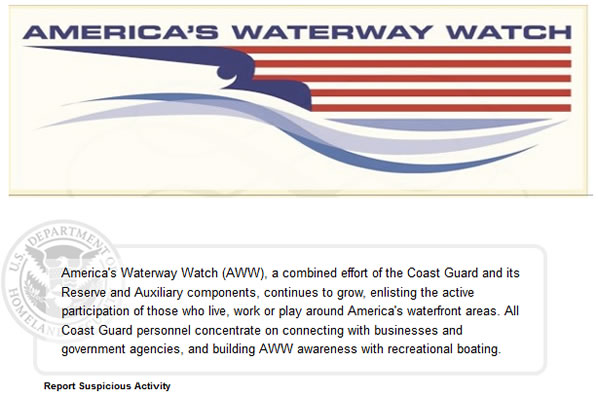America's Waterway Watch

Always remember that people are not suspicious, behavior is!
Am I witnessing a threat or a crime?
Most of us have found ourselves wondering this at some time or other. However, because we are not really sure, we tend to ignore what we have just seen and, hoping it wasn't so, we continue about our business. Prior to September 11, 2001 this would have been an acceptable reaction. But times have changed, and we no longer have that luxury. Keeping in mind that "People aren't suspicious, behavior is," here are some situational examples of behaviors and activities that may help you determine what is suspicious and, thus, what should be reported:
- Unusual operations of a vessel, small boat, or a boat and vehicle on land.
- People taking still photos or video tape of bridges, trains or tracks, U.S. buildings, government vessels or facility's or other items that might be used to cause harm to the U.S.
- A person running away from an area close to a secure facility.
- A person engaged in what looks like surveillance
- Suspicious Conditions or Physical breaches of security
There are other items, just the renting of a boat that can be a warning sign. Below is an example.
You work at a business that rents small boats by the hour. In the process of renting a boat for the day "to do some fishing," two men ask about the "best fishing spots" on the bay and, pointing in the direction of the Navy base to the North, ask if that might not be a good place to fish. You tell them, "No, the best fishing is in the South Bay area." They fill out the paperwork, and pay you the required deposit and "full day" rate with a credit card. Neither of them seem all that interested in the terms of the contract, nor in the fact that they are not entitled to a partial refund if they return before the end of the day. You then help them load the boat with obviously brand-new fishing equipment and two large coolers, and take the time to remind them, "It might be a good idea to buy some bait." After you check them out on operation of the boat, they leave the dock -- and head North in the direction of the Navy base. The whole situation starts to seem strange to you, including the fact that the person's recently issued drivers license provided as proof of identity, the bank credit card used for payment, and the license plate on their vehicle were from three different states. Individually, each of the oddities in this situation do not rise to the level of "suspicious behavior," but when viewed in their totality they do.
What should I do?
First call the National Response Center at 877-24WATCH. For immediate danger to life or property call 911, or call the Coast Guard on Marine VHF-FM Channel 16.
NEVER approach someone you fear may be about to commit an illegal act or crime. Make some notes, such as the person's appearance, clothing, car license plate, and the type of boat, vehicle or aircraft involved. Take a picture if you can, but keep your distance if the situation seems hostile.
Provide details:
Be specific in details whenever you report something amiss to authorities. Generalized descriptions and concerns (e.g., "That guy looks shifty to me...") don't provide sufficient information and may not carry the appropriate sense of urgency.
Details carry weight:
"I'm at the Safe Haven Marina and just saw [something dangerous] loaded from a silver SUV into a white Boston Whaler with the registration number of CF1234YZ. I can't read the SUV's plate number, but I think it's an out of state plate. The boat operator seems to be intimidated by his passengers; and the passengers seem to be trying to keep out of sight. I think something bad is about to happen." Pay attention to height, weight, gender, clothing, or other identifiable traits of the people engaged in suspicious activity -- you may be asked for this type of information.
